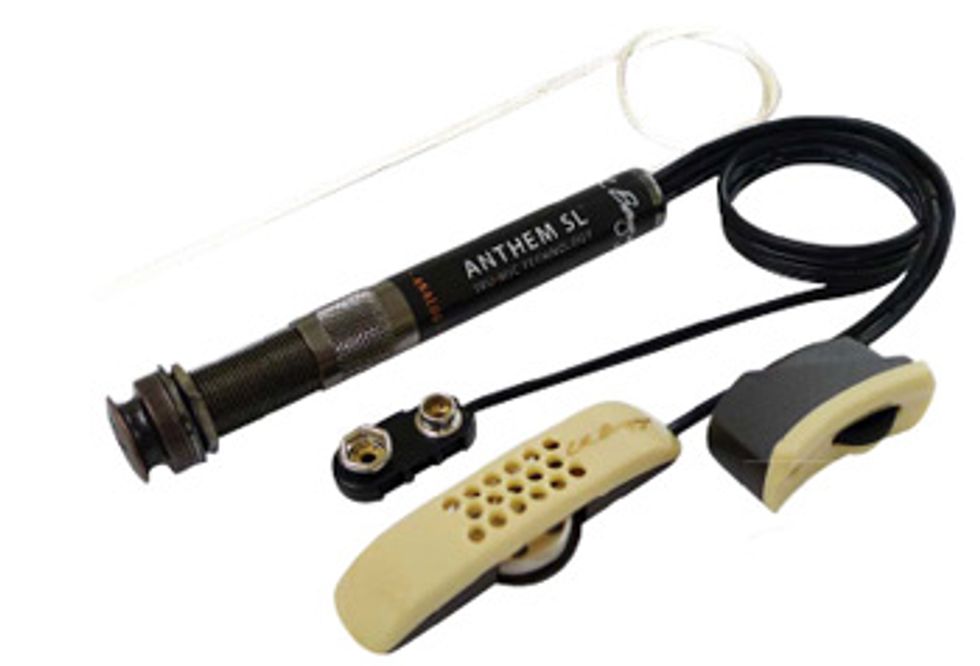  | |
| Download Example 1 No Pickup (mic'd for reference) | |
| Download Example 2 Element | |
| Download Example 3 Tru-Mic | |
| Download Example 4 Both sources blended | |
Acoustic pickups are almost always a compromise:
Do you want your amplified tone
to sound like a guitar or do you want it
to be loud? Typically, the louder you get
with, say, an undersaddle solution, the less
woody warmth you enjoy. But if you go for
a realistic-sounding pickup that captures the
tonal gorgeousness of your special baby, a
loud signal may require a lot of EQ—which
is going to suck tone and make things a lot
less woody and warm.
Indeed, compromise may be inherent in
the world of acoustic amplification. But few
pickup makers have walked the line and
bridged that gap between authentic tone
and performance-level volume as well as
L.R. Baggs. And with the introduction of the
Anthem Tru-Mic, they’ve taken another step
toward reducing compromises for the amplified
acoustic player.
What is it?
The Anthem Tru-Mic system is built around a
super lightweight (.5 oz) microphone housed
in a small plastic enclosure mounted inside
your guitar’s body and affixed with double-sided
tape to the bridge plate. In this
configuration, the mic hovers just 3 mm from
the guitar’s bridge plate—effectively capturing
the vibrations of the entire soundboard,
but focusing on signals above 250 Hz. The
system also incorporates the Baggs Element,
an undersaddle transducer that captures
audio below 250 Hz for a powerful one-two
punch: the Tru-Mic gives you the breathy,
microphonic quality that’s missing in most
pickups, and the undersaddle Element gives
you the sparkling detail and enhanced bass
response you crave. The Anthem also makes
use of the company’s noise-canceling technology
to virtually eliminate feedback.
Volume and Blend controls, as well as a
Phase switch and battery indicator, are located
out of the way of errant picking strokes
and placed just inside the bass side of the
soundhole on a discreet onboard preamp.
There’s also a small trim pot for fine-tuning
the volume of the Tru-Mic in relation to the
output of the Element pickup. The Blend
control enables you to move from an almost
entirely Tru-Mic signal (with a little Element
signal for support in the bass frequencies)
to a pure Element, or to find a sweet spot
somewhere between the two.
The Anthem is as unobtrusive a system as
you’re likely find, too. Apart from the soundhole
controller, which is all but invisible at
more than a few paces away, there’s little
clue that there’s a very sophisticated pickup
system onboard. It’s also worth noting that
installation of the Anthem system is best left
to a professional.
Rich and Loud
The Anthem System came to us installed
in a Martin M38—a damn fine guitar that
sounded simply awesome. Surely some readers
will say, “Yeah, well you attach a tin can
with a string to that and it’s gonna sound
great.” But the very balanced voice of the
M38 proved a perfectly appropriate platform
for evaluating the Anthem system across a
wide frequency spectrum.
In a word, the Anthem sounds outstanding.
I played it through an L.R. Baggs Acoustic
Reference Amplifier and a Fishman
SA220, and it rocked my world. The signal
remained free of feedback, distortion, or
any other harmonic unpleasantness with
even the loudest amp settings. In fact,
the Anthem tended to retain more of the
guitar’s acoustic qualities the louder it
got, until at times it sounded like a guitar
the size of a pipe organ: rich, sustaining,
and very loud. Highs were smooth and
brilliant, never harsh or spiky. Mids—typically
the frequency most likely to reveal a
pickup system’s shortcoming in the form
of quack or feedback—were remarkably
well defined, with a total absence of harsh
nasality. And the bass sounds, generated
with a combination of the Tru-Mic
and the Element, were awesome without
being woofy or overwhelming, and without
inducing groaning feedback.
I did have a chance to use this guitar live for
a duo gig with my drummer Eric in a medium-
sized, L-shaped venue. Eric is a pretty
aggressive player, and as the night went on
his playing got a bit rowdier. But the Anthem
had no problem rising above his caffeinated
exuberance. Each note was clear, and both
of us could be heard perfectly through the
entire space. The guitar tone remained pure
guitar, regardless of crowd noise or the percussive
power behind me.
Because of its highly accurate signal, the
Anthem system also opens up an interesting
world of recording possibilities, where
blends of the Anthem signal and an organic
mic’d signal can be split to create greater
girth and ambience in an acoustic track.
The Verdict
Thankfully for all of us who perform live with
acoustic guitars, acoustic amplification technology
has grown by leaps and bounds. But
L.R. Baggs has taken a truly giant leap forward
with the Tru-Mic Anthem system. And
by focusing on a microphone-oriented solution—
an approach that many players and
certainly engineers regard as the best way to
capture a guitar’s natural tone—L.R. Baggs
is helping raise the bar for what players can
expect from an accessibly priced system.
Buy if...
you have a gorgeous-sounding guitar that deserves to he heard in all its glory when you plug it in.
Skip if...
you are still working your way up the high-end-guitar food chain.
Rating...
Street $299 - L.R. Baggs - lrbaggs.com |






![Rig Rundown: Russian Circles’ Mike Sullivan [2025]](https://www.premierguitar.com/media-library/youtube.jpg?id=62303631&width=1245&height=700&quality=70&coordinates=0%2C0%2C0%2C0)

















